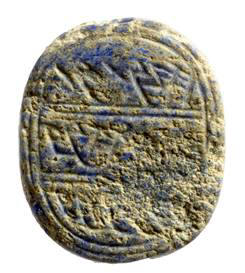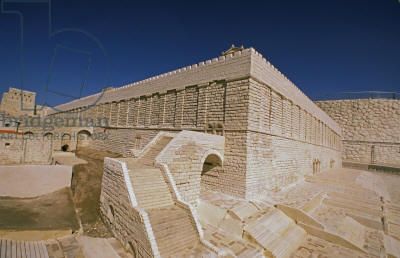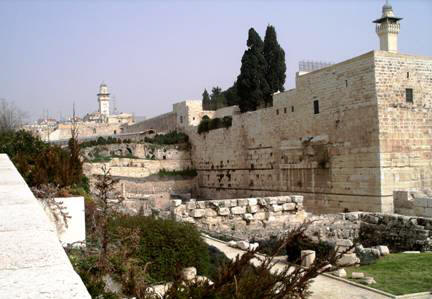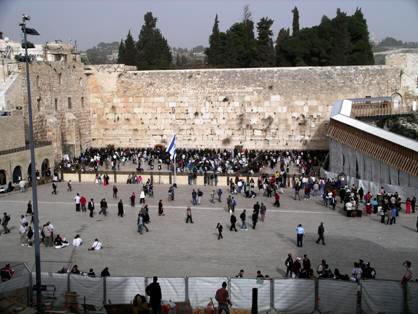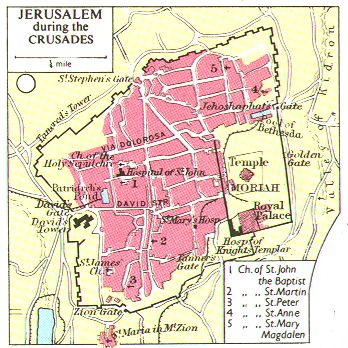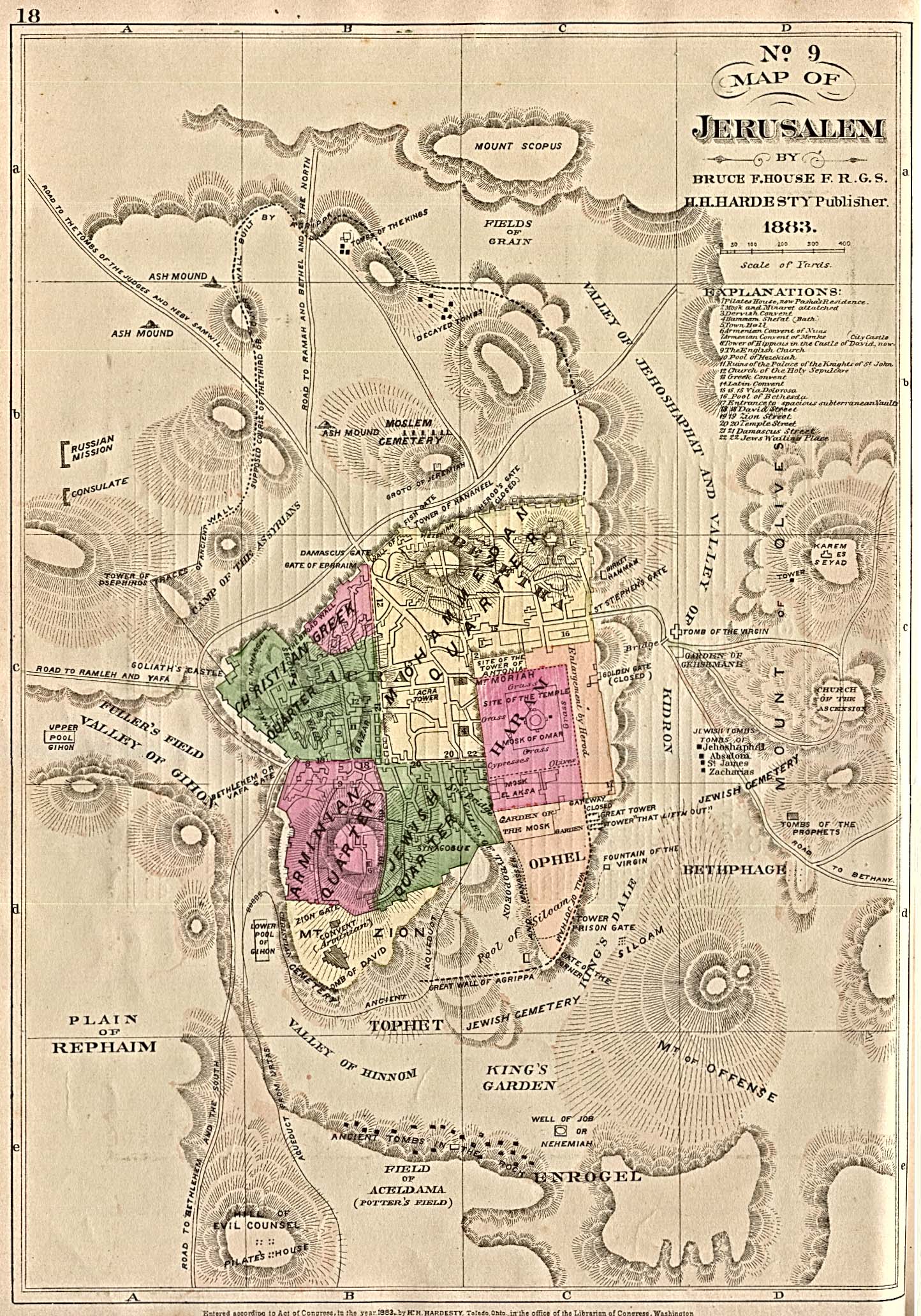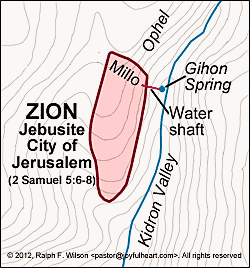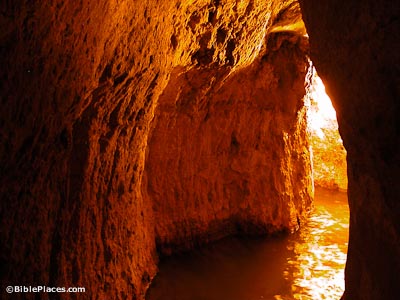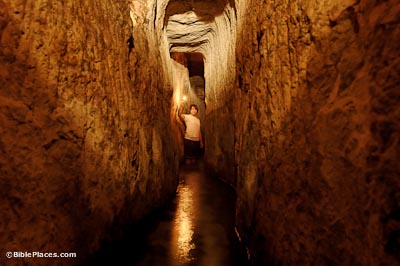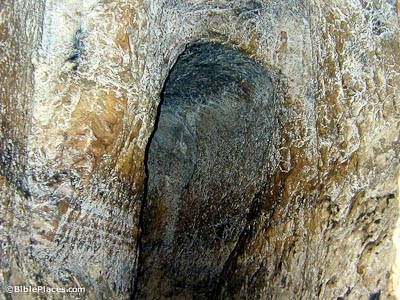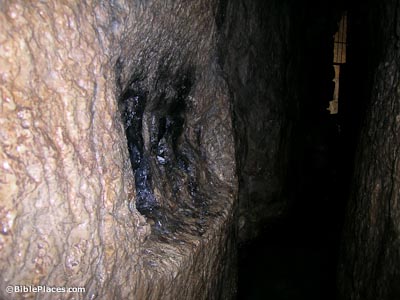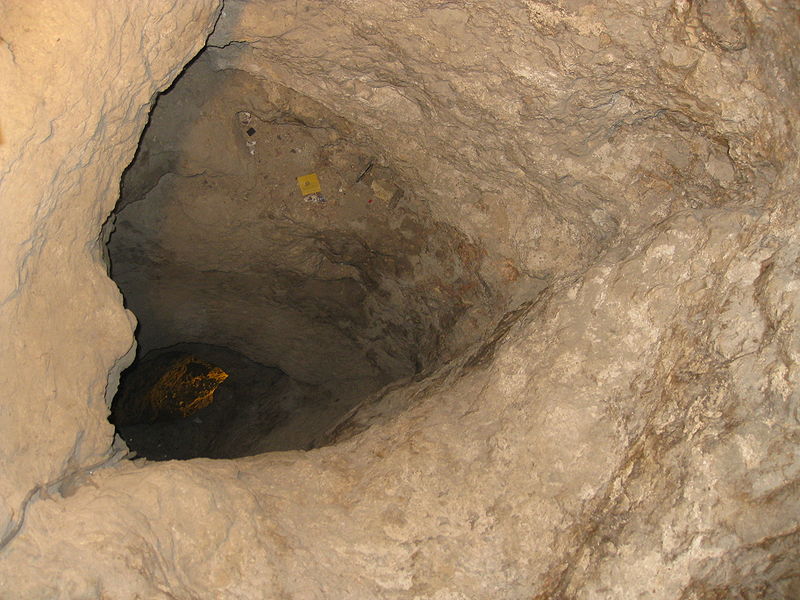Apparently, Jesus had left the Temple
proper, and was outside the Temple mount to the south probably close to
the Pool of Siloam. There was a road that led from the south west corner
of the temple mount that pass by the Pool of Siloam. Jesus could have
left through either the double or triple gates in the south Temple wall.
Those who went to the Temple to worship were required to be ceremonially
clean before proceeding up the road and entering the Temple area. This
would be accomplished in Pool of Siloam which was a large "mikvah".
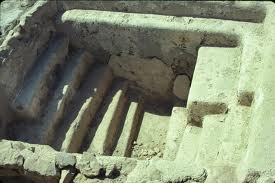
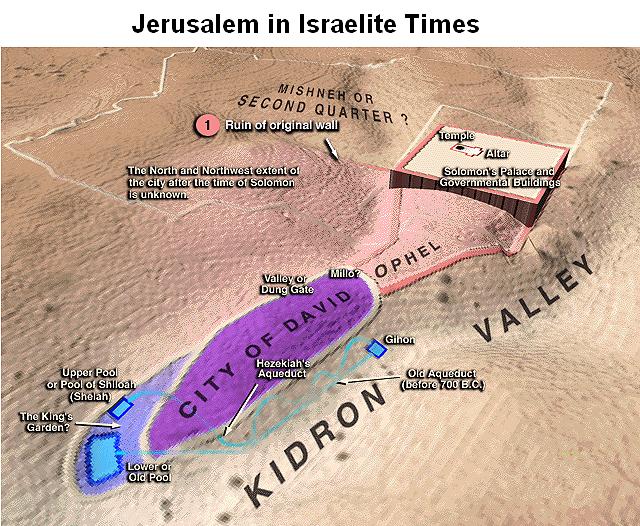 |
The mikvah is
a ceremonial bath used in ritual cleansing or purification. The
Pool of Siloam was such a bath. It was required that the mikvah be
supplied by running water and that the person would be immerced
in order to fulfill the purification requirement. The Jew would
enter one side of the mikvyah,
enter the water being fully immersed and then proceed to leave
the pool by the other side. He would then proceed to the Temple
for worship. The pool of Siloam is fed by a conduit that is cut
for a distance of 1,780 feet through solid rock, which starts at
the so-called Virgin's Spring (En-rogel) or Gihon Spring. The
reason for which it was cut is unmistakable. The Virgin's Spring
is the only spring of fresh water in the immediate neighborhood
of Jerusalem, and in time of siege it was important that, while
the enemy should be deprived of access to it, its waters should
be made available for those who were within the city. We cannot
be sure that this immediately followed the events of Chapter
Eight when the Jews sought to stone Him. John records in verse 2
that Jesus' disciples were with Him and they are not mentioned
in Chapter Eight. This could have happened the same day or
later. Robertson writes, based on the grammar of the words "as
Jesus passed by" this was a later event.
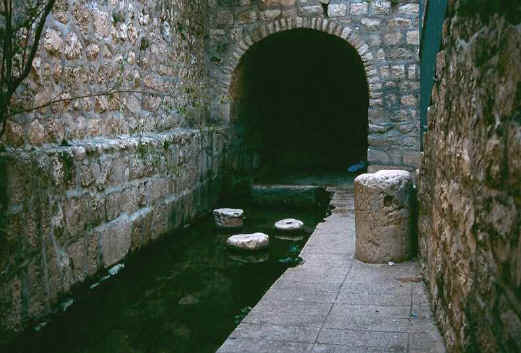 |
Hezekiah's Tunnel, where it comes out at the Pool of
Siloam, counts as a mikveh.
The author met a young Jewish man who had just been
into the tunnel to immerse himself in readiness for the
upcoming holy day.
|
|
"And as Jesus passed by, he saw a man which was blind from his
birth." (John 9:1)
The area near the Pool of Siloam was a busy area with lots
of people passing by daily. The blind man was probably there begging for
alms. The area near the Pool of Siloam was a busy area with lots of
people passing by daily. The blind man was probably there begging for
alms and as an adult and born he would have had no other way to support
himself. As Jesus and the disciples passed they saw the man and asked ".
. . who did sin, this man, or his parents, that he was born blind?"
"And his disciples asked him, saying, Master, who did sin, this
man, or his parents, that he was born blind? Jesus answered, Neither
hath this man sinned, nor his parents: but that the works of God
should be made manifest in him. I must work the works of him that
sent me, while it is day: the night cometh, when no man can work."
(John 9:2-4)
It was a
common belief of the Jews that parents who were sinful or amiss in their
obedience to God or religious duties could past the results of their sin
on to their unborn children. Therefore a child born with some physical
imperfection was seen as suffering from the sins of the parents. Some
held to the false view of pre-existence in which the child in its
pre-existence sinned and therefore caused the deformity in his present
life. This gives us some insight into the religious views of the Jews
which came from the teachings of the Pharisees. Although they were
informed about the law, they were clearly deficient in their
understanding of origins of sin. Romans 5:12 explains "Wherefore,
as by one man sin entered into the world, and death by sin; and so death
passed upon all men, for that all have sinned" (Romans
5:12) When Adam sinned, as the progenitor of the human race he sinned
and passed to all men the nature to sin. Every man then is born with a
"carnal"or nature to sin which means to"miss the mark." (John 9:2-4)
Jesus' did not address their false beliefs, but simply stated that
neither this man nor his parents had sinned. Paul explained "For when we
were in the flesh, the motions of sins, which were by the law, did work
in our members to bring forth fruit unto death." (Romans 7:5) The term
"flesh" refers to the carnal or sinful nature of man which is the source
of all wrong doing and rebellion. A man in his natural unregenerated
state can only do what his nature allows him to do. Paul explicates
writing "But the natural
man receiveth not the things of the Spirit of God: for they are
foolishness unto him: neither can he know them, because they are
spiritually discerned." (1
Corinthians 2:14) The unbeliever in his natural state has no spiritual
nature, which is the nature of God received by the baptism of the Holy
Spirit being born again when a person believes in Jesus Christ for their
salvation. (John 9:2-4) Jesus used a common used phrase which compares
day and night to life and death. While it was day and light, He was
alive and able to accomplish God's will. However, Jesus predicts His
death referring to it as night when men cannot work because of the
darkness.
"As long as I am in the world, I am the light of the world. When
he had thus spoken, he spat on the ground, and made clay of the
spittle, and he anointed the eyes of the blind man with the clay,
And said unto him, Go, wash in the pool of Siloam, (which is by
interpretation, Sent.) He went his way therefore, and washed, and
came seeing." (John
9:5-7)
Jesus
literally states He was light to the world as long as He was in the
world. Luke explains why Jesus came into the world "Through the tender
mercy of our God; whereby the dayspring from on high hath visited us, To
give light to them that sit in darkness and in the shadow of death, to
guide our feet into the way of peace." (Luke 1:78-79) John also explains
"Then spake Jesus again unto them, saying, I am the light of the world:
he that followeth me shall not walk in darkness, but shall have the
light of life." (John 8:12) Jesus as the Light of the world is referring
to the truth that He was the Messiah come to earth to free men from the
curse of sin and death. The truth was the light. John 1:1 says Jesus was
the Word (Logos) which means the truth and is called "light." One can
see this truth John 3:19 "But he that doeth truth cometh to the light,
that his deeds may be made manifest, that they are wrought in God."
(John 3:21) The word "light" has a further function in the enabling of
the believer to respond to the truth and apply it in his life. John
further tells us that a man can reject and actually hate the light
because of his love of sin.
Jesus
when He had said this demonstrated His ministry of showing Himself as
the Messiah by performing a miracle in healing the blind man. Jesus
could have simply spoken and the blink man would have received his
sight, but Jesus had a reason for spitting on the ground and placing the
wet clay on the man's eyes. He directed the blind man to wash in the
pool of Siloam. The man obeyed the Lord and was instantly healed as he
washed in the pool.
People
who had physical deformities were seen as unclean and their present
would defile the Temple area because their imperfection countered the
purity of God. Leviticus 21:17-21 restricted man having any physical
affliction from serving as a priest. Even physically normal people were
required to be washed clean before they could enter the Mount. This
washing was done in the Pool of Siloam. The blind man then would not
have been allowed to enter the Temple area. There Jesus told him to go
to the pool and wash in the pool of Siloam. The Lord did not say for him
to wash his eyes, but simply to wash which because of the custom would
mean to immerse himself completely in the water.
"The neighbours therefore, and they which before had seen him
that he was blind, said, Is not this he that sat and begged? Some
said, This is he: others said, He is like him: but he said, I am he.
Therefore said they unto him, How were thine eyes opened? He
answered and said, A man that is called Jesus made clay, and
anointed mine eyes, and said unto me, Go to the pool of Siloam, and
wash: and I went and washed, and I received sight. Then said they
unto him, Where is he? He said, I know not." (John
9:8-12)
Once the
man entered the pool and washed his received his sight. John's record
simply matter of factly states the events, but this must have cause
quite a stir with the people who witnessed this and also with the once
blind man. We cannot imagine what his reaction was when the clay was
washed away and for the first time in his life he open his eyes and saw
his surroundings. It would be an understatement to say he greatly
rejoiced in now being able to see.
His
"neighbors" meaning fellow Jews who knew of his blindness now saw him
walking around and that he now could see. It seems in astonishment they
said to one another "Isn't this the man who was blind and sat and
begged?" His healing could have changed his appearance and therefore
brought into question if this was the once blind beggar. Many blind
people have deformed or discolored eyes. However, the man healing we
complete and he was made whole totally cured and was not immediately
recognized. Some said this was the man and other were not so sure.
However, the man who had sat and begged for such a long time spoke and
emphatically declared, "I am he."
The
group then asked the obvious question "How did you receive your sight?"
The man replied explained that the man named Jesus had anointed his eyes
with clay and told him to wash in the pool of Siloam, and he had washed
as he was told and could not see. It is well to note that in the man's
account he did not mention Jesus spiting and making the clay he placed
on the man's eyes. The reason seem clear that the man being blind did
not see what Jesus did, but only knew he had place the moist clay on his
eyes. This seemingly minor detail shows the accuracy of God's word.
Those
present now asked the man where was Jesus? Apparently, the Jesus had not
followed the man to the pool and the man did not know where Jesus was
now.
"They brought to the Pharisees him that aforetime was blind. And
it was the sabbath day when Jesus made the clay, and opened his
eyes. Then again the Pharisees also asked him how he had received
his sight. He said unto them, He put clay upon mine eyes, and I
washed, and do see." (John
9:13-15)
The
people who had witnessed the healing and had questioned the man then
took him to the Pharisees. The Pharisees were the religious and civil
leaders of the people and this wonderful and unusual event warranted the
man being shown to the Jewish rulers. The Pharisees as Robertson states
were the accepted professional teachers who posed as knowing everything
so it would logical to bring the matter to them for an explanation. Thus
the rulers proceeded in questioning the man and asked how he had
received his sight. The man again recounts that he had obeyed Jesus and
now could see.
This is
an interesting point, because Jesus had been telling these same men to
believe on Him and follow or obey His teachings. Of course they had
refused. Now standing before them was a man born blind who obeyed and
the result was Jesus had healed Him. The point could not be mistaken
that this proved that believing and obeying Christ had a positive
effect.
The
Pharisees showed the hearts by immediately, even upon seeing the results
of a true miracle of God standing before them, condemned Jesus because
He healed on the Sabbath. They concluded that Christ could not be of God
because He had broken the Sabbath. But the truth was that Jesus had not
violated the Sabbath, but one of their man made self-righteous laws. The
law gave provision for the rescue of even animals who needed help.
"Therefore said some of the Pharisees, This man is not of God,
because he keepeth not the sabbath day. Others said, How can a man
that is a sinner do such miracles? And there was a division among
them." (John 9:16)
The
miracle could not be denied that this man born blind had received his
sight when he obeyed Jesus. Some blatantly denied Him, and others being
more honest concluded that a "sinner" could not do such miracles. There
was division among them. Throughout history when Jesus is presented,
taught, or preached there is a division among those who hear of Him. In
our politically correct Western society to mention the name of Jesus
bring sharp reaction. Jesus Christ was not politically correct when He
was on earth and has not been even to our day. He is in direct
opposition to the atheistic society that denies godly moral principles
and upholds every sin and perversion of man. Jesus is in our day is
being received by our government and leaders in society in the same way
He was when He was on earth. His message is the same today, "I tell you,
Nay: but, except ye repent, ye shall all likewise perish." (Luke 13:3)
Sinful men do not like to be rebuked and their sin and warned of the
eventuality of their end in hell.
Note
what Matthew records was Jesus' instructions to His disciples when He
sent them forth to preach the kingdom. "But whosoever shall deny me
before men, him will I also deny before my Father which is in heaven.
Think not that I am come to send peace on earth: I came not to send
peace, but a sword. For I am come to set a man at variance against his
father, and the daughter against her mother, and the daughter in law
against her mother in law." (Matthew 10:33-35) (Also see Luke 12:51)
In
contrast Jesus when He told the disciples of the coming of the
Comforter, the Holy Spirit He said, "Peace I leave with you, my peace I
give unto you: not as the world giveth, give I unto you. Let not your
heart be troubled, neither let it be afraid." (John 14:27) The different
in the responses to Jesus Christ is that some believe Him as the Holy
Spirit begins conviction to their hearts. Others, so harden by their sin
shut up their hearts and minds to the truth and reject the Lord. They do
not truth stand in the way of their unbelief. It is interesting that
those who reject Him almost always are greatly offended outwardly and
respond with attacks meant to discredit Him. Their response shows that
deep down they do know the truth, but refuse to openly admit it. Thus
they quench the convicting power of the Holy Spirit in a foolish attempt
to justify themselves.
"They say unto the blind man again, What sayest thou of him, that
he hath opened thine eyes? He said, He is a prophet. But the Jews
did not believe concerning him, that he had been blind, and received
his sight, until they called the parents of him that had received
his sight." (John
9:17-18)
Again,
as if they could somehow disprove what they knew to be true they
continued their interrogation of the blind man again asking him what was
their explanation of who Jesus was and what He had done. The blind man
responded that Jesus was a prophet. In Israel's history it was the
prophets that God has used to speak to the people and do miracles or
signs before them. The clear implication was that the believed that
Jesus was a prophet sent from God. Still seeking to disprove the miracle
they refused to believe the man had been born blind so they call his
parents to continue their examination.
"And they asked them, saying, Is this your son, who ye say was
born blind? how then doth he now
see? His parents answered them and said, We know that this is our
son, and that he was born blind: But by what means he now seeth, we
know not; or who hath opened his eyes, we know not: he is of age;
ask him: he shall speak for himself. These words spake his parents,
because they feared the Jews: for the Jews had agreed already, that
if any man did confess that he was Christ, he should be put out of
the synagogue. Therefore said his parents, He is of age; ask him." (John
9:19-23)
Clearly,
the parents did not help the unbelieving Jews in discrediting the Jesus.
They simply but tactfully replied that the man was their son and that he
was born blind. But whether they knew the details of how their son had
received his sight or not, they did say. In their defense, it is
possible did not know any more than their son had related to them. They
said they did not know who or how he had received his sight, but that he
was of age and responsible for himself. As an adult he could legally
testify for himself before the court. John records the parents would not
respond further because the Jewish leaders had said they would cast
anyone out of the synagogue if they confessed that Jesus was the
Messiah. It could be that his parents realizing the great miracle of
their son receiving his sight believed that Jesus was the Messiah, but
were not willing to publicly commit themselves to being believers.
John
does not identify those the parents feared as the Jewish rulers, but
simply s the calls them "Jews" This passage provides strong evidence of
the technical use of the term "the Jews." Doubtless these parents were
Israelites, but they were not "Jews" in the sense of being part of the
ruling class. The title "Jews" in this context was identifying the
hierarchical and ecclesiastical-political authorities and not the
populace of the nation of Israel.
False
churches, and Christian cults always practiced excommunication. It is a
way to control their members and maintain their authority. However,
salvation is between a man and God and it is God who imparts salvation
to a man and if received it is eternal. Even God does not practice
excommunication. Further, God has not given any church, which is
biblically an assembly of believers, the authority to give or take alway
salvation. Churches can and should practice "church discipline" which
means breaking fellowship with members who are in open sin and refuse to
repent. Church members who openly and publicly sin bring dishonor to the
name of Christ and the congregation. In order to return them to
fellowship with the Lord and to not condone sin, the local church is
instructed to disfellowship them.
"Then again called they the man that was blind, and said unto
him, Give God the praise: we know that this man is a sinner. He
answered and said, Whether he be a sinner or no, I know not: one
thing I know, that, whereas I was blind, now I see. Then said they
to him again, What did he to thee? how opened he thine eyes?"(John
9:24-26)
Four
times the Jewish rulers ask the man who was healed to denounce Jesus.
What a paradox that they would instruct him to give God the praise for
his being healed, but to brand Jesus, who was the means of his healing
as a sinner. The could not deny the miracle had occurred by blinded by
their pride and self-righteous arrogance refused to accept that Jesus
had healed him. To do so would have been to admit Jesus' claims as being
the Messiah, the Son God as being true. They condemned Jesus as a
sinner, which meant He had nothing to do with the healing. They based
their condemnation on His healing a man on the Sabbath day. The man
simply replied he did not know whether Jesus was a sinner or not, but he
absolutely knew he could now see. Still seeking some justification for
their aspersion of Jesus' character they ask the man again what had
Jesus done and how he had opened his eyes. It seems they were trying
desperately to get the man to say Jesus was the Messiah, whereas they
then could cast him out of the synagogue and discredit him.
Most
believers have the same response to their receiving salvation. Whereas
the sinner was once blind to God's truth and salvation, now through the
miracle of redemption their eyes are opened and they can see the truth.
We can not the biblical facts of that God saves the sinner, but we
cannot comprehend God's act beyond what we know. "But
God commendeth his love toward us, in that, while we were yet sinners,
Christ died for us." (Romans
5:8) Can we truly fathom the love of God that He would suffer and die,
paying for the sins of the one who sins against Him? The statement is
rhetorical and the answer is "No" we cannot truly grasp the infinite
love of God that saves the sinner, but we can be grateful and praise God
for His mercy and grace.
"He answered them, I have told you already, and ye did not hear:
wherefore would ye hear it again? will ye also be his disciples?
Then they reviled him, and said, Thou art his disciple; but we are
Moses' disciples. We know that God spake unto Moses: as for this
fellow, we know not from whence he is." (John
9:27-29)
Each
time the man is questioned his answers get better. This fourth time the
man responses with great wisdom and also some indignation in their
persistence in not accepting his answers. The once blind man asked them
why they wanted to hear his answer again and added, "is it you want to
be His disciples." There can be no question the man was rebuking them
for their obstinance. His rebuke brought a swift response form his
questioners as they began to revile him, which means the tone of their
questions changed to being abusive and contemptuous as they accuse him
of being Christ's disciple.
The
replied they were Moses' disciples and they knew God had spoken to Moses
and given him the law. But Jesus had supposedly broken the law and thus
He, in their blinded eyes, could not from God. If we go back to John
3:1, we can see the deception and bias in their statement. Nicodemus saw
Jesus' miracles and knew that no one could do these miracles unless God
was with Him. We see the same understanding among the people in Luke
7:11f when Jesus raised the son of he widow from Nain from the dead. "And
there came a fear on all: and they glorified God, saying, That a great
prophet is risen up among us; and, That God hath visited his people." (Luke
7:16)
"The man answered and said unto them, Why herein is a marvellous
thing, that ye know not from whence he is, and yet he hath opened
mine eyes. Now we know that God heareth not sinners: but if any man
be a worshipper of God, and doeth his will, him he heareth. Since
the world began was it not heard that any man
opened the eyes of one that was born blind. If this man were not of
God, he could do nothing." (John 9:30-33)
The man
then, clearly led of the Holy Spirit begins to boldly preach to these
self-righteous Jewish leaders. He points out vividly the foolishness of
their denying that Jesus was from God. These were not merely ignorant
common men, but the elite of Israel; those who were superior in
knowledge and position in Israel. Yet this beggar, with no formal
training, scorns their arrogance and exposes their unwarranted prejudice
against Jesus. The man brilliantly presents a vital principle of
biblical interpretation that any conclusion as to the meaning of an
biblical event or statement must be interpreted in the analogy of the
faith. He did this by pointing out the irrefutable fact that God does
not hear sinners. That means God cannot bless error or be a party to the
works of a man unless the work is in line with God's principles. The man
reminds them that Isaiah prophetically stated, speaking of the latter
days, "Then the eyes of the blind shall be opened, and the ears of the
deaf shall be unstopped. Then shall the lame man leap as an hart, and
the tongue of the dumb sing: for in the wilderness shall waters break
out, and streams in the desert." (Isaiah 35:5-6) Many times Isaiah
refers to the spiritually blind and deaf having their eyes and ears
opened to God's truth. (See Isa. 29:18) But in Chapter 35 the context is
plainly addressing the physical blessings that God would give Israel in
the promised kingdom (the Millennium). Isaiah 32:1 sets the context for
Chapters 32-36 , which begins this discourse of s a Messianic prophecy
"Behold, a king shall reign in righteousness, and princes shall rule in
judgment." (Isaiah 32:1) The "king" is the promised coming Messiah.
Therefore Isaiah prophesied of the great miracles and prosperity that
would accompany the coming of the Messiah. The wonder of the once blind
man's statement is that he was apparently aware of God promises, but the
biblical scholars of Israel where not. One thing he reminded the rabbi
was never in history had a man born blind received his sight. Only God
could heal and restore the a blind man's sight, thus there was no
grounds for their statements that Jesus was a sinner or that God was not
with Him.
"They answered and said unto him, Thou wast altogether born in
sins, and dost thou teach us? And they cast him out." (John
9:34)
As
mentioned earlier, the response of the carnal heart, when exposed, is
always to personally attack the one who reveals their error. Note the
rulers did not address the man's statements, but judged the man as born
in sin and therefore not worthy to instruct them who presented
themselves as the spiritual leaders of Israel. The phrase "born in sin"
refers back to 9:2 which was the question the disciples asked. They
meant the man was a vile sinner who had sinned in some pre-existence or
whose parents had sinned, thus disqualifying the man from having any
spiritual incite or to address them who were the religious class of
Israel.
Their
response was to excommunicate him from the synagogue which also meant he
was ostracized from Jewish society as well. They effectively branded the
man as the worst of sinners and unfit to be among the rest of Jewry.
"Jesus heard that they had cast him out; and when he had found
him, he said unto him, Dost thou believe on the Son of God? He
answered and said, Who is he, Lord, that I might believe on him? And
Jesus said unto him, Thou hast both seen him, and it is he that
talketh with thee. And he said, Lord, I believe. And he worshipped
him." (John 9:35-38)
The
excommunication was a serious matter and was done publicly as to be a
warning to others. It can be assumed the man was somewhat distraught
over what had happen even knowing that he was right. Jesus of course
knew immediate what had transpired, but before His disciples and the
people showed His compassion and went to where the man was to further
instruct him.
Jesus'
question to the man perfectly and absolutely presents God's plan of
salvation. Jesus asks the simply question "Do you believe on the Son of
God?" He did not ask the man what religious works he had done, or even
of the man's character. Jesus asked the crucial question? "Do you
believe." As baffling as it was to the once blind man, that the
Pharisees after seeing Jesus miracles would questioned that Jesus was
from God, is that so many churches and religious leaders of today ignore
that salvation is by faith alone apart from works. Yet, so many in
Christendom, mix belief and works thus presenting a false Gospel. Jesus
went to the man to instruct him in how he could be saved. If salvation
was of belief plus works, such as baptism, church membership, sacraments
or any other rite or religious act why did not Jesus explain this to the
man? The answer is plain...salvation is be belief by faith alone in the
Son of God who offers believers redemption, forgiveness of sins and
eternal life as His free gift. God says:
"For by grace are ye saved through faith; and that not of
yourselves: it is the gift of God: Not of works, lest any man should
boast." (Ephesians
2:8-9)
Jesus
Himself said to Nicodemus when He instructed Him in how to be born
again:
"For God so loved the world, that he gave his only begotten Son,
that whosoever believeth in him should not perish, but have
everlasting life. . . .He that believeth on the Son hath everlasting
life: and he that believeth not the Son shall not see life; but the
wrath of God abideth on him." (John
3:16, 36)
The man
asked Jesus who is the Son of God that he could believe in Him. There
can be no question that Jesus asserted His deity and position to the
man. Jesus said to the man he had seen the Son of Man and it was He who
was speaking to him. The man both spiritually and physically was seeing
Jesus the Christ and He savingly believed on Him. The man response was
perfect evidence of true salvation, in that He immediately worshiped
Jesus. This man though not formally trained was instructed enough in the
matters of God to know that one only worships God. To worship any other
that God was blasphemy. Always the man whose eyes are spiritually opened
to who Jesus is will bow before Him. The man's earlier statement to the
Jewish leaders now takes on great significance when he said, " . . .
whereas I was blind, now I see." (John 9:25b)
"And Jesus said, For judgment I am come into this world, that
they which see not might see; and that they which see might be made
blind. And some of the Pharisees which were with him heard these
words, and said unto him, Are we blind also?" (John
9:39-40)
Jesus'
instructions to the man was not done in private as verse 40 shows.
Listening on the side lines were some of the Pharisees who heard Jesus'
words. For their benefit Jesus stated that He had not come to bring
judgment, but to open the eyes of the spiritually blind. It is amazing
that for days now the religious leaders had railed on Jesus, belittled
and humiliate Him, but He in His mercy and grace explains to these men
He had not come to judge them unto condemnation, but to show them the
truth. Once again their response exposed their true spiritual condition.
With indignance and pride they asked Jesus were they too blind?
How
often does one see the blindness which causes those false religious
leaders and cults to be offended when the truth is presented. In their
pride they considered themselves to be far superior to other men as the
knowledgeable spiritual leaders of the Jews. Their position in their
minds put them far beyond any self examination or possibility of being
in error. The illustration fits perfectly that is often heard that if a
rock is thrown into a pack of dogs the one who is hit is the one who
howls. Clearly, truth had struck home and they lashed out in a vain
defense.
"Jesus said unto them, If ye were blind, ye should have no sin:
but now ye say, We see; therefore your sin remaineth."
(John 9:41)
Jesus candidly responded that, "yes" they were blind. He explains that
because they denied they were sinners they were guilty of their sin.
This presents another vital part of how salvation is received. Only the
person admits to being a sinner will see the need for forgiveness and
God's mercy. The self-righteous and confident in their worthiness of
God's favor, thus they see no need of grace. Jesus had just told the man
who was healed that salvation was by faith in Him as the Son of God. The
Pharisees denied Jesus was the Messiah, the Son of God, and their
unbelief was vividly apparent . Thus their denial of His miracles and
message being of God, showed the hardness of their hearts and therefore
their sins could not forgiven. God cannot save the unrepentant.
